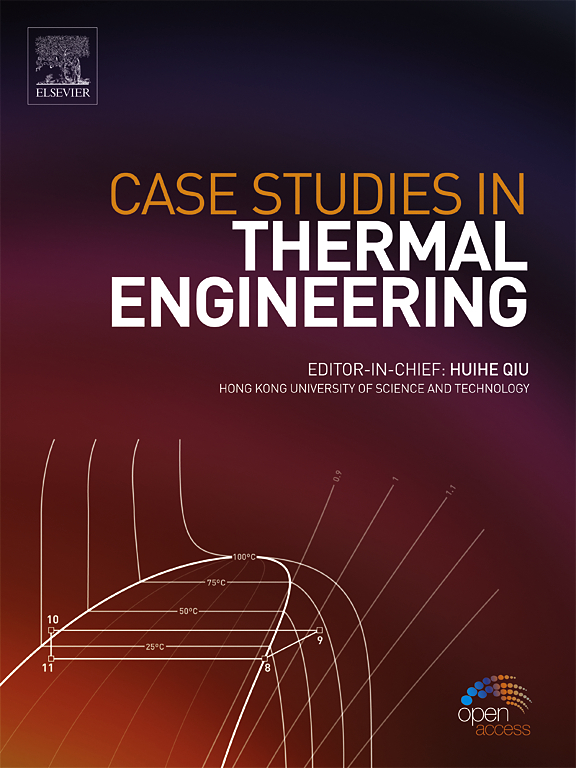带纳米流体和多射流撞击的带肋微通道中传热和熵生成的数值研究
IF 6.4
2区 工程技术
Q1 THERMODYNAMICS
引用次数: 0
摘要
由于电子设备的高度微型化,迫切需要消除电子设备中的高热通量并改善其传热特性。本文模拟了单相流,研究了五种不同的柱肋布置方式和不同体积浓度(1%-5%)的纳米流体对多射流撞击(MJI)肋式微通道散热器中对流传热系数、压降和流体传热不可逆性在 Re 200-1000 范围内的影响。工作冷却剂为去离子水和水-Al2O3 纳米流体。研究了不同的重要参数,如传热和流动特性、性能评估标准(PEC)和熵生成。结果表明,MJI III 能有效提高对流传热系数,而压降的增加并不明显。在 Re = 600 时,MJI III 的 PEC 为 1.408,远高于其他 MJI。此外,在研究范围内,水-Al2O3 纳米流体的冷却性能和不可逆性均优于去离子水。随着浓度的增加,水-Al2O3 纳米流体的流动和传热不可逆性也随之增加。数据显示,当 φ = 1 % 时,整体性能最佳,当 Re = 400 时,最高 PEC 为 1.75。本文章由计算机程序翻译,如有差异,请以英文原文为准。
Numerical study of heat transfer and entropy generation in ribbed microchannel with nanofluid and multiple jet impingement
Due to the high miniaturization of electronic devices, there is an urgent need to eliminate high heat flux in electronic devices and improve their heat transfer characteristics. This article simulated the single-phase flow to study the effects of five different arrangements of column ribs and different volume concentration (1 %–5%) of nanofluids on the convective heat transfer coefficient, pressure drop, and the irreversibility of flow heat transfer in ribbed microchannel heat sinks with multiple jets impingement (MJI) within the Re range of 200–1000. The working coolants is deionized water and water - Al2O3 nanofluid. Different important parameters, such as the characteristic of heat transfer and flow, Performance Evaluation Criterion (PEC), and entropy generation are investigated. The results indicated that MJI III can effectively improve the convective heat transfer coefficient while the increase in pressure drop is not obvious. The PEC of MJI III is 1.408 at Re = 600, which is much higher than the other MJIs. Additionally, the cooling performance and irreversibility of water-Al2O3 nanofluid are superior to those of deionized water within the research scope. With the concentration, the irreversibility of flow and heat transfer of water-Al2O3 nanofluid increasing increases. The data shows that, the overall performance is optimal when = 1 %, and its highest PEC is 1.75 at Re = 400.
求助全文
通过发布文献求助,成功后即可免费获取论文全文。
去求助
来源期刊

Case Studies in Thermal Engineering
Chemical Engineering-Fluid Flow and Transfer Processes
CiteScore
8.60
自引率
11.80%
发文量
812
审稿时长
76 days
期刊介绍:
Case Studies in Thermal Engineering provides a forum for the rapid publication of short, structured Case Studies in Thermal Engineering and related Short Communications. It provides an essential compendium of case studies for researchers and practitioners in the field of thermal engineering and others who are interested in aspects of thermal engineering cases that could affect other engineering processes. The journal not only publishes new and novel case studies, but also provides a forum for the publication of high quality descriptions of classic thermal engineering problems. The scope of the journal includes case studies of thermal engineering problems in components, devices and systems using existing experimental and numerical techniques in the areas of mechanical, aerospace, chemical, medical, thermal management for electronics, heat exchangers, regeneration, solar thermal energy, thermal storage, building energy conservation, and power generation. Case studies of thermal problems in other areas will also be considered.
 求助内容:
求助内容: 应助结果提醒方式:
应助结果提醒方式:


